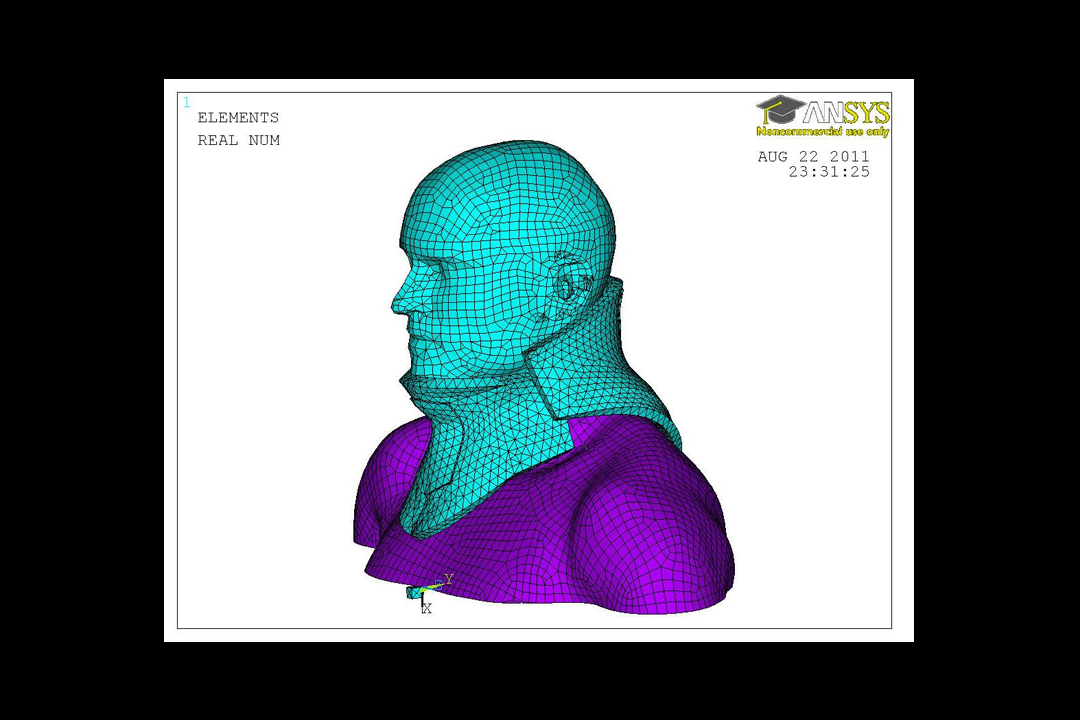Neck Assessment Tool

Research Centre
Art and Design Research Centre
Date
2012
An engineering simulation of the head, neck and upper torso has been developed using Finite Element Analysis
People with Motor Neurone Disease (MND) often develop weak neck muscles, leading to pain, restricted movement and problems with swallowing, breathing and communication. Ideally, a neck collar would help alleviate these. However, neck collars currently available are of limited use for people with MND and often rejected by patients. The same is true for patients with neck weakness due to other conditions.
The Head-Up project is a 2-year study funded by the National Institute for Health Research's Invention for Innovation, or i4i, programme with a budget of £400k. Its principal aim is to develop a novel neck orthosis for neck weakness that supports whilst allowing freedom to move without negatively impacting quality of life. The research is a collaboration between clinicians, engineers, creative designers, patients and carers who will be working closely together in a co-design process. Manufacturers will be brought into this process at a later date. Ethical approval has been granted where necessary for all participatory elements.
Methods
The co-design process will inherently elicit subjective views. As such, prior to starting this work package, it was considered necessary to create a measure for this subjectivity and to give the design team a greater empathetic understanding of the inadequacies of current provision for this user group. This has been achieved by a combined clinical comfort assessment and engineering simulation.
An engineering simulation of the head, neck and upper torso has been developed using Finite Element Analysis. This has been called the Neck Assessment Tool (NAT). Real body geometry was obtained via a 3D laser scan. The neck has been modelled without any structural integrity, such that the head will drop without support. The body model has been meshed and constrained to represent this scenario. The geometry of different neck collar models were created in separate files and meshed. Individually they are imported into the body model, appropriate contact conditions applied and the model is processed. Each model tells the researchers where there is contact between body and collar and, relatively, the pressure of that contact.
A clinical comfort assessment pilot study has been conducted using the design team members. This is based on location mapping from the McGill pain questionnaire and a Visual Analogue Scale. 5 different neck collars were identified based on common usage and distinct design differences. The members of the research team wore each collar for a day with recovery periods between. During each test period the participants recorded locations of pain/discomfort and perceptions of relative associated scales. They recorded other data relating to emotional reactions caused by the collars, impact on specific Activities of Daily Living (ADL's) and aesthetic considerations.
Results
The NAT has been conducted on 2 collars and the comfort assessment on 5, 2 of which are those tested in NAT. Comparisons between the comfort assessment and NAT demonstrate acceptable correlation, validating the simulation. The comfort assessment participant reporting forms have been refined and recruitment is under way to roll out to a wider population of health volunteers and use with MND volunteers to report about experiences of their specific collars as and when used. The design team reported significant differences in their perceptions of neck collars before and after the comfort assessment that will positively impact the co-design process.
Researchers involved
Dr Joseph Langley - Senior Research Fellow, Lab4Living
Related projects
Design4Health - Design4Health is a series of conferences and publications bringing...
Head UP - Many people with Motor Neurone Disease (MND) develop weak neck muscles,...
Lab 4 Living - Lab4Living is a collaborative research initiative between the Art and Design..

